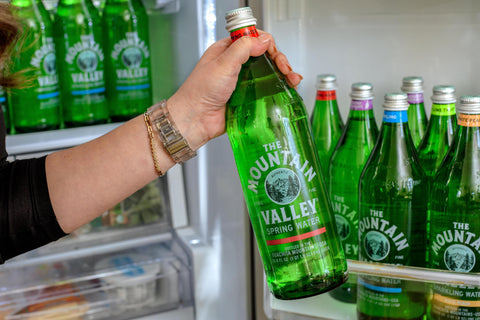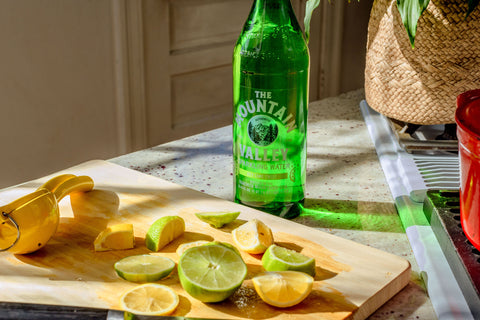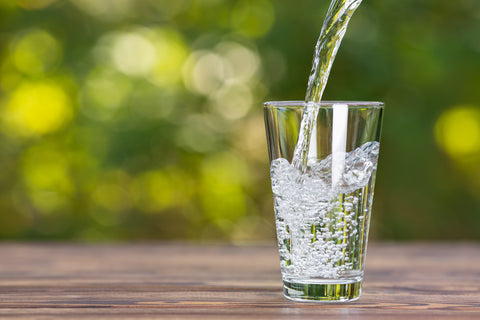
Mineral water might just be the perfect drink. Naturally infused with the trace minerals our bodies need and naturally un-messed-around-with, mineral water is water perfected by Mother Nature. Mineral water offers all the wonderful hydration of water, plus it has bonus benefits that make it even healthier, even tastier and even more refreshing.
First things first: What is mineral water?
What is mineral water?
The Food & Drug Administration defines mineral water as water that “comes from an underground source and contains at least 250 parts per million total dissolved solids. Minerals and trace elements must come from the source of the underground water. They cannot be added later.”
To put that in everyday terms: Mineral water must come from the earth, and it must draw its minerals from the earth — not from a processing plant or bottling facility. Some of the minerals most commonly found in mineral water include calcium, potassium, sodium and magnesium. Other naturally occurring trace minerals found in mineral water are fluoride, copper and zinc.

How do minerals get into mineral water?
Mineral water, as stated by the FDA, must come by its minerals naturally. This happens through contact with the layers of soil and earth that form underground reservoirs and aquifers. As the water passes through these layers — after falling from the sky as rain, perhaps, or on its way back up to the earth’s surface via a spring — the water’s surrounding sediment infuses the liquid with its minerals.
Should water pass over limestone, that limestone may leave behind traces of calcium in the water. Should water pass through dolomite, the dolomite may infuse it with traces of magnesium and more calcium. Should water pass through igneous rocks and/or granite, those mediums may impart it with potassium.
To be clear, there won’t be pebbles of magnesium in a bottle of mineral water. These minerals appear in trace amounts that cannot be measured with the naked eye. As mentioned earlier, the FDA requires 250 parts per million of total dissolved solids for water to be considered mineral water. That means, of 1 million particles of water, 250 of them — a mere .025% — must be dissolved solids such as magnesium, calcium, potassium, sodium, etc. Those are tiny amounts, but they can do mighty things.

What do these minerals do for one’s health?
Sure, some waters contain minerals. But what do those minerals do exactly? In many cases, healthful and wonderful things.
Here’s a breakdown:

Mineral water vs. tap water
While both mineral water and tap water contain trace minerals and dissolved solids, these two waters do not come by these minerals in the same way.
Mineral water must gain its minerals naturally, through contact with the earth and its sedimentary layers. Tap water, on the other hand, faces several hurdles before it pours its way into homes and offices.
Tap water may come from surface sources — lakes, ponds, rivers — or from underground sources such as reservoirs. Public water suppliers move this water from the source and into treatment plants where the water must undergo chemical disinfection to make it safe to drink under the guidelines of the Safe Water Drinking Act. After chemically disinfecting the water, these treatment facilities add minerals, such as calcium, magnesium and potassium, to the water to give it a better, more rounded taste.
Tap water makes its way to homes via underground pipes. These pipes may impart the water with more minerals and dissolved solids — both good and bad. Rusted and leaking pipes may pollute tap water and can negatively impact not only tap water’s drinkability but also its safety.
Mineral water, however, comes from a natural spring and is bottled at the source. While mineral water often undergoes filtering and processing to remove potentially harmful substances, this type of water is naturally mineralized.

What’s even better/tastier/refreshing-er/more award winning than mineral water? Mountain Valley Spring Water
While Mountain Valley Spring Water isn’t technically “mineral water” per the FDA’s guidelines — Mountain Valley has approximately 220 parts per million of total dissolved solids, not the 250 required by the FDA — Mountain Valley Spring Water is award-winningly delicious and packed with trace minerals.
Here’s the Mountain Valley mineral breakdown:
- Calcium: 69-74 parts per million
- Magnesium: 7.2-13 ppm
- Potassium: 0.9-1.2 ppm
These minerals find their way into Mountain Valley Spring Water naturally — and slowly.
Ever.
So.
Slowly.

Mountain Valley’s water fell from the skies some 3,500 years ago as rain and snow. It filtered into granite-based aquifers and then back to the surface of our valley-based spring through layers of limestone, quartz and Ordovician marble. This unique process infuses our water with a delicious blend of minerals that give Mountain Valley its crisp, rounded and award-winning flavor. It’s a process that cannot be replicated in a factory — though many try.

Mountain Valley Spring Water, with its natural trace minerals, offers many of the benefits of mineral water with the added bonus of exceptional flavor. Our crisply refreshing, purely sourced, naturally mineralized water has earned Mountain Valley loads of awards and legions of loyal fans all across the U.S.
See what the fuss is about for yourself. Get started with home or office delivery of Mountain Valley Spring Water here.































